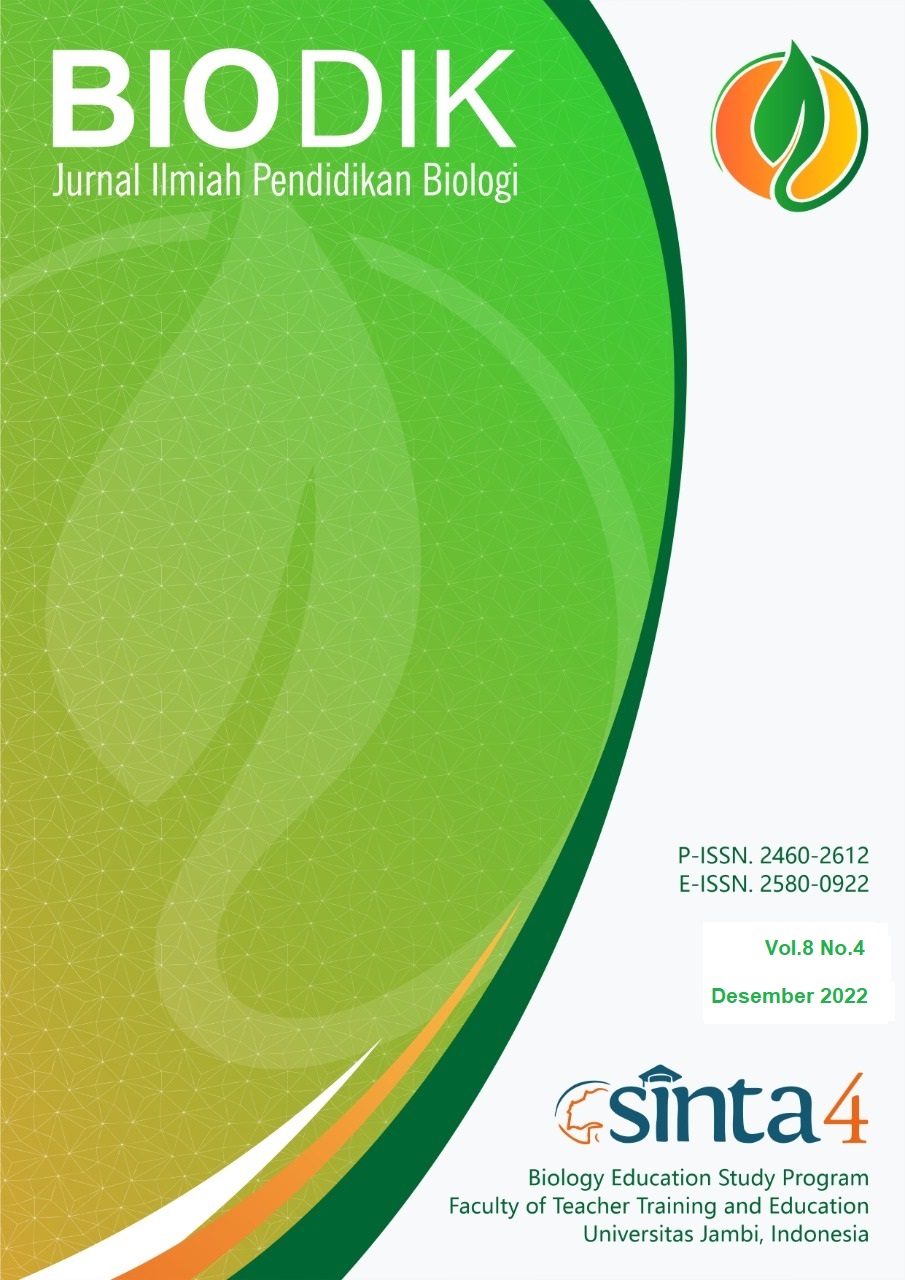Pengaruh Model Meaningful Instructional Design terhadap Beban Kognitif Konstruktif Siswa SMA
(The Effect of Meaningful Instructional Design on Germane Cognitive Load of High School Students)
DOI:
https://doi.org/10.22437/bio.v8i4.19077Abstract
This study aims to determine the effect of the application of the Meaningful Instructional Design (MID) model on the level of germane cognitive load on high school students in XI degree. The research used pra-experimental method with One Group Pretest-Posttest design as a research design. The data was colected with a written test. The kind of instrument used is the Reasoning Test instrument to measure the score of Learning Outcomes (HB). The data analysis technique used statistical test and independent sample t-test. The sample in this study consisting of one class that was taken using a purpossive sampling technique, in XI MIPA 4 at SMAN 1 Nagrak. The GCL level of students after learned using the Meaningful Instructional Design model was in the tended to be high category with the average score of HB=73.68 and the acquisition of sig. (2-tailed) is 0.00<0.05 for the independent sample t-test result. Based on the students' average Learning Outcomes scores and sig. (2-tailed) on the hypothesis test, it can be concluded that there is a significant positive effect with the application of the Meaningful Instructional Design model on the germane cognitive load of high school students.
Keywords : Germane Cognitive Load, Meaningful Instructional Design.
ABSTRAK
Penelitian ini bertujuan untuk mengetahui pengaruh dari penerapan model Meaningful Instructional Design (MID) terhadap tingkat beban kognitif konstruktif siswa SMA kelas XI. Jenis penelitian yang digunakan adalah pra-experimental dengan desain penelitian One Group Pretest-Posttest. Teknik pengumpulan data menggunakan tes tertulis. Isntrumen yang digunakan yaitu instrumen Tes Penalaran untuk mengukur skor Hasil Belajar (HB). Teknik analisis data menggunakan uji statistik dan uji dua rerata (Independent Sample T-Test). Dengan sampel dalam penelitian ini yang terdiri dari satu kelas yang diambil menggunakan teknik purpossive sampling, yaitu pada kelas XI MIPA 4 di SMAN 1 Nagrak. Tingkat GCL siswa setelah mendapatkan prmbelajaran menggunakan model Meaningful Instructional Design (MID) berada dalam kategori cenderung tinggi dengan skor rata-rata HB=73.68 dan perolehan nilai sig. (2-tailed) 0,00<0,05 untuk hasil uji independent sample t-test. Berdasarkan nilai rata-rata Hasil Belajar siswa dan sig. (2-tailed) pada uji hipotesis dapat disimpulkan bahwa terdapat pengaruh positif yang signifikan dari penerapan model Meaningful Instructional Design terhadap beban kognitif konstruktif siswa SMA.
Kata Kunci : Beban Kognitif Konstruktif, Meaningful Instructional Design
Downloads
References
Agustina, R., Sipahutar, H., & Harahap, F. (2016). Analisis Miskonsepsi Pada Buku Ajar Biologi SMA Kelas XII. Jurnal Pendidikan Biologi, V(02), 113-118.
Ardayeni, Ektin., dkk. (2019). Analisis germane Cognitive Load Siswa Ditinjau dari Gaya Belajar Matematis pada Pembelajaran Contextual Teaching and Learning. Banten: Universitas Sultan Ageng Tirtayasa
Arikunto, S. (2013). Prosedur Penelitian: Suatu Pendekatan Praktik. Jakarta: Rineka Cipta.
Budianto, dan A. Jihan. (2018). Pengaruh Strategi Ekspositori Terhadap Hasil Belajar Siswa Pada Submateri Sistem Saraf Manusia di Kelas XI SMA Swasta YAPIM Medan. Best Jurnal. Vol. 1 No. 02Hal. 01 – 06
Brunken, R., Seufert, T., & Paas, F. (2010). Measuring Cognitive Load. Dalam Plass J. L. Moreno R., & Brunken, R. (eds.). Cognitive Load Theory. Cambridge: Cambridge University Press.
Clark, R., Nguyen, F., Sweller J. (2006). Efficiency in Learning: Evidence Based Guidelines to Manage Cognitive Load. San Francisco: Pfeiffer.
Cooper, G. (1990). Cognitive load theory as an old for intruction design. Australia journal for education technologi, 6(2), 108-103. https://doi.org/10.14742/ajet.2322
Kalyuga, S. (2010). Cognitive load theory: Schema acquistion and sources of cognitive. Cambridge: Cambridge University Press.
Kurfika, K. Rizki. (2018). Analisis Beban Kognitif Siswa Sma Sesuai Gaya Belajar Vark Pada Pembelajaran Dunia Tumbuhan Menggunakan Reciprocal Teaching. Universitas Pendidikan Indonesia
Marzano, R. J. dkk. (1993). Assessing Student Outcomes, Performance Assessment using the Dimensions of Learning Model. Alexandra: Association for Supervison and Curriculum Development.
Mayer, R. E. (2002). Rote versus meaningful learning. Theory into Practice, 41, 226–232. https://doi.org/10.1207/s15430421tip4104_4
Mayer, R. E. (2002). Cognitive theory and the design of multimedia intruction: An example of the two way street between cognition and instruction. New directions for teaching and learning.
Pangesti, F. T. P. (2015). Efek cognitive load theory dalam mendesain bahan ajar geometri. Seminar Nasional M atematika Dan Pendidikan M atematika Universitas Negeri Yogyakarta.
Shoimin. Aris. (2014). 68 Model Pembelajaran Inovatif dalam Kurikulum 2013. Yogyakarta: Ar-Ruzz Media
Suprijono, Agus. (2014). Cooperative Learning. Yogyakarta: Pustaka Media
Suyatno. (2009). Menjelajah Pembelajaran Inovatif. Sidoarjo: Masmedia Buana Pustaka.
Downloads
Published
How to Cite
Issue
Section
License
Copyright (c) 2022 Lingga Nurma Mukarromah Lingga, Setiono, Sistiana Windyariani

This work is licensed under a Creative Commons Attribution-NonCommercial-ShareAlike 4.0 International License.
Copyright Notice
Authors who publish with Biodik : Jurnal Ilmiah Pendidikan Biologi agree to the following terms:
- For all articles published in Biodik : Jurnal Ilmiah Pendidikan Biologi, copyright is retained by the authors and grant the journal right of first publication with the work simultaneously licensed under a Creative Commons Attribution-ShareAlike 4.0 International Licensethat allows others to share the work with an acknowledgment of the work's authorship and initial publication in this journal.
- Authors are able to enter into separate, additional contractual arrangements for the non-exclusive distribution of the journal's published version of the work (e.g., post it to an institutional repository or publish it in a book), with an acknowledgment of its initial publication in this journal.
- Authors are permitted and encouraged to post their work online (e.g., in institutional repositories or on their website) prior to and during the submission process, as it can lead to productive exchanges, as well as earlier and greater citation of published work (See The Effect of Open Access).
















